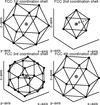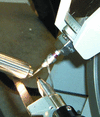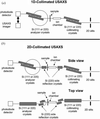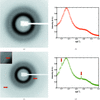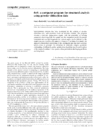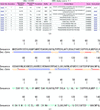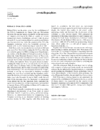issue contents
June 2009 issue

Cover illustration: Three-dimensional reconstructed crystal (purple), loop (yellow) and solvent (transparent pink) for a native DNA sample. Courtesy of Brockhauser, Di Michiel, McGeehan, McCarthy & Ravelli [J. Appl. Cryst. (2008), 41, 1057-1066].
research papers
Grazing-incidence X-ray diffraction is combined with a two-dimensional pixel detector to obtain three-dimensional reciprocal-space maps of InAs nanowires grown by molecular beam epitaxy.
Open  access
access
 access
accessThe majority of previously deposited X-ray structures can be improved by applying current refinement methods.
Download citation


Download citation


A modification to the usual least-squares analysis is implemented, to refine structural parameters from powder diffraction data containing an unmodeled impurity. The method is characterized using known materials, and two new structures are refined using the method.
The use of high-energy X-rays as a tool to map the diffuse scattering in reciprocal space is discussed. Particular emphasis is put on the influence of multiple scattering effects on the measured intensity distributions.
For ideal specimens, thin-film thickness values obtained from high-resolution X-ray diffraction techniques have accuracies of about 1 nm and precisions one or two orders of magnitude smaller. The use of multiple X-ray techniques is required to ensure reliable thickness determination.
The etch figures of three forms ({11 0}, {2
0}, {2
 0} and {10
0} and {10 1}) of the self-frequency-doubling crystal Yb:YAl3(BO3)4 were observed and the point group 32 was displayed. Etch figures of faces or sections with the same indices in Yb:YAl3(BO3)4 and quartz are very similar, although their crystal structures are very different.
1}) of the self-frequency-doubling crystal Yb:YAl3(BO3)4 were observed and the point group 32 was displayed. Etch figures of faces or sections with the same indices in Yb:YAl3(BO3)4 and quartz are very similar, although their crystal structures are very different.
Open  access
access
 access
accessSupposing the Hill grain-interaction model, it is demonstrated that X-ray elastic constants can be used to determine mechanical elastic constants of cubic fibre-textured thin films. The new approach is demonstrated by the experimental characterization of out-of-plane moduli of fibre-textured Cu and CrN thin films.
Hard synchrotron X-ray microdiffraction is used to quantify the orientation distribution of ettringite crystals [Ca6Al2(OH)12(SO4)3·26H2O], which cause cracking and loss of strength in concrete structures.
The enantiomorphs of an ambient-pressure superconductor κ-(BEDT-TTF)2Cu(NCS)2 [BEDT-TTF is bis(ethylenedithio)tetrathiafulvalene] have been successfully identified using the method of convergent-beam electron diffraction. This indicates that a micrometre-sized small crystallite is enough to identify its enantiomorphs even in an organic crystal. Stacking faults in κ-(BEDT-TTF)2Cu(NCS)2 have also been found, the existence of which has not been noted from conventional X-ray diffraction methods.
The decrease of average atomic coordination number with size in nanocrystals is evaluated using calculations based on ideal spherical crystals.
The size distribution and morphology of silicon nanoparticles have been studied using small-angle X-ray scattering and transmission electron microscopy. Milled particles exhibit surface fractal characteristics and a high size dispersion, whereas particles produced by silane pyrolysis are smooth with a monodisperse distribution.
The development of a prototype environmental gas cell, capable of allowing a single crystal to be exposed to different gas mixtures and/or a vacuum whilst in situ on the single-crystal diffractometer, is reported along with an initial case study.
Small-angle neutron scattering (SANS) studies of glucose/xylose isomerase indicate that the structure of this protein in solution is very stable and very similar to that in the crystal, in a broad pressure range up to 150 MPa. This enzyme can be used as a secondary standard for SANS measurements.
The design and operation of a versatile ultra-small-angle X-ray scattering instrument at the Advanced Photon Source at Argonne National Laboratory are presented.
The recent interpretation in the literature of the diffraction pattern of top-seeded BaTiO3 as a hybrid structure of monoclinic and tetragonal phases is dismissed in favour of a twinning model, which has been derived from single-crystal CCD diffraction data and confirmed by simulations. BaTiO3 at room temperature is proved conclusively to be a single phase of tetragonal symmetry.
A new high-performance diffracted-beam analyzer consisting of multiple pieces of a perfect crystal in the form of a simple and compact device is proposed. The X-ray intensity diffracted from the analyzer can be increased by, for example, one order of magnitude compared with that obtained with an ordinary single-crystal analyzer.
An approach to correct for the effect of sample displacement from the Bragg plane on peak position is described for reflection-mode Debye–Scherrer geometry and applied to determine the relationship between composition and lattice parameter in Smx/2Ndx/2Ce1−xO2−δ ceramics.
Measuring the anisotropic properties of materials, such as phonon densities of states, is possible on an anisotropic polycrystal with a well known orientation distribution function (ODF). With this purpose, the ODF is characterized by Rietveld and Mössbauer texture analysis.
Energy-dispersive diffraction data from the Synchrotron Radiation Source at Daresbury Laboratories have been analysed using crystal-structure-based Rietveld refinement. A standardless quantification method has been developed to analyse directly in energy space rather than in d space. Standard mixtures have been quantified to verify the method which has then been applied to a tomographic study of an electrochemical cell.
An analytic expression has been derived which connects the degree of preferred orientation in a polycrystalline material to the March parameter. The latter defines the spread of angular distribution of crystallite inclinations in the March–Dollase approach.
A general method to determine the surface crystallography and therefore the shape of faceted nanoparticles by transmission electron microscopy is proposed.
cryocrystallography papers
The minimal concentrations of three common cryoprotectants were determined for high-pressure cryocooling of water in thick-walled plastic capillaries. The substantial reduction in the minimal concentrations by high-pressure cryocooling can be of significant use in high-throughput X-ray protein structure determination.
short communications
This paper describes the design of various sample cells providing a controlled environment for small single crystals or epitaxial thin films during diffraction experiments.
Download citation


Download citation


Open  access
access
 access
accessA novel method that enables single-crystal diffraction data to be obtained from a powder sample is presented.
computer programs
The ReX software provides a user-friendly environment for structural analysis using powder diffraction data.
HATODAS II, which provides comprehensive suggestions for the heavy-atom derivatization of protein crystals, is described.
laboratory notes
A model of an air cooler in a laboratory furnace is presented. The setup allows for simultaneous regulation of different crystallization fronts and rates in crucible columns, enabling rapid acquisition of crystals in an undergraduate laboratory.
addenda and errata
Free 

Errors in the paper by Yokoyama & Harada [J. Appl. Cryst. (2009), 42, 185–191] are corrected.
crystallographers
Free 

Free 



 journal menu
journal menu




















